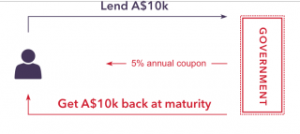Assignment 1-3 Definitions
Term: Bond
Introduction:
I am writing this post in order to define the term “bond”, most commonly used in the field of economics. The definition will be written to address a non-technical audience. I will write as an economics professor explaining the term “bond” to her first-year university students during a lecture. I will provide three types of definitions: parenthetical, sentence, and expanded. Words that a non-technical audience won’t understand when they are first told the parenthetical and sentence definition will be further explained in the expanded definition. The information used to define the term will be from my personal knowledge as an economics student as well as from online websites.
Parenthetical Definition:
Loans issued by corporations and governments that pay a fixed interest rate.
Sentence Definition:
Bonds are long/short term loans issued by corporations and governments that traditionally pay a fixed interest rate. Corporations and governments use bonds to borrow money from investors (people like us) to raise funds for things like building roads or buying equipment. Bonds are regarded as low-risk investments as governments and good credit-rated companies (such as Apple, Starbucks) are highly unlikely to miss their promised payments of a fixed amount.
Expanded Definition:
What is a bond?
Bonds are a type of fixed income that borrowers pay the investors at a specified date in future and at a fixed interest rate. Although sometimes before the full payment of the bond is due, investors are liable to receive fixed payments at regular intervals (refer to Type 2). Bonds are the most common form of low-risk investment. It is easy to issue them publicly or over the counter by almost anyone and they are certain to be paid, as it is very uncommon that the government or a company with a high credit rating would go bankrupt.
What do we mean by a fixed interest rate?
Interest rate refers to the amount paid by the borrower additional to the amount lent by the investor. When a bond is issued, this rate (sometimes also called the coupon rate in the context of bond issuance) is fixed and so no matter what happens to the economy and/or the company over the time period (maturity period) of the bond, the rate of interest received by the investor neither increase nor decreases.
What is the purpose of a bond?
There are two main purposes of issuing a bond. Corporations and governments issue bonds to raise funds for their projects and common people like us lend a certain amount of money to them in order to receive a higher amount later in the future. Unlike typical savings at a bank, bond investments have higher interest rates.
What are the different types of bonds?
There are many types of bonds, but the ones commonly issued are explained below:
- Zero-coupon bonds- bonds that don’t make coupon payments (payments at intervals) but are redeemed for their full value upon maturity.
- Treasury notes (T-notes)- A type of US government bond that earns a fixed rate of interest every six months (coupon rate) and has maturities ranging from 1 to 10 years.
- Municipal bonds- issued by state and local governments
- Corporations bonds- issued by corporations and business to fund large capital investments or business expansions.
What happens when a bond is issued?
There are two distinct processes of bond issuance that can be simply explained by zero-coupon bonds and treasury notes. These processes are visually illustrated below.
Type 1: Zero-Coupon Bond

Figure 1: Illustrates the process of issuing a zero-coupon bond
Source: HSBC Global Asset Management Hongkong “Fixed income 101”
Type 2: Treasury notes (T-notes)

Figure 2: Illustrates the process of issuing a Treasury note (T-note)
Source: “What Are Government Bonds?” IG
What are the basic characteristics of a bond?
- Face value: is the final money amount the bond will be worth at the final date of maturity. It is the total amount of money received by the investor on the final day.
- Maturity date: is the date on which the bond issuer (borrower) will pay the bondholder (investor) the face value of the bond.
- Coupon rate: is the rate of interest the bond issuer will pay on the face value of the bond. For example, 10% annual coupon rate means that bondholders will receive 10% x $1000 face value = $100 every year (refer to Type 2: Treasury notes (T-notes) above)
- Coupon dates: are the dates on which the bond issuer will make interest payments. Payments can be made in any specified interval. (refer to Type 2: Treasury notes (T-notes) above)
- The issue price: is the price at which the bond is first sold to the investor.
Sources
Hayes, Adam. “Bond.” Investopedia, Investopedia, 10 Apr. 2020, www.investopedia.com/terms/b/bond.asp.
The Economist, The Economist Newspaper, www.economist.com/economics-a-to-z/b#node-21529458.
“Types of Bonds.” Article: Types of Bonds: Types of Bonds, www.buschinvestments.com/Types-of-Bonds.c71.htm.
“Fixed Income 101.” HSBC Global Asset Management Hongkong, www.assetmanagement.hsbc.com.hk/en/intermediary/investor-resources/investment-academy/fixed-income-101#openTab=0.
“What Are Government Bonds?” IG, www.ig.com/en/bonds/what-are-government-bonds.
Leave a Reply